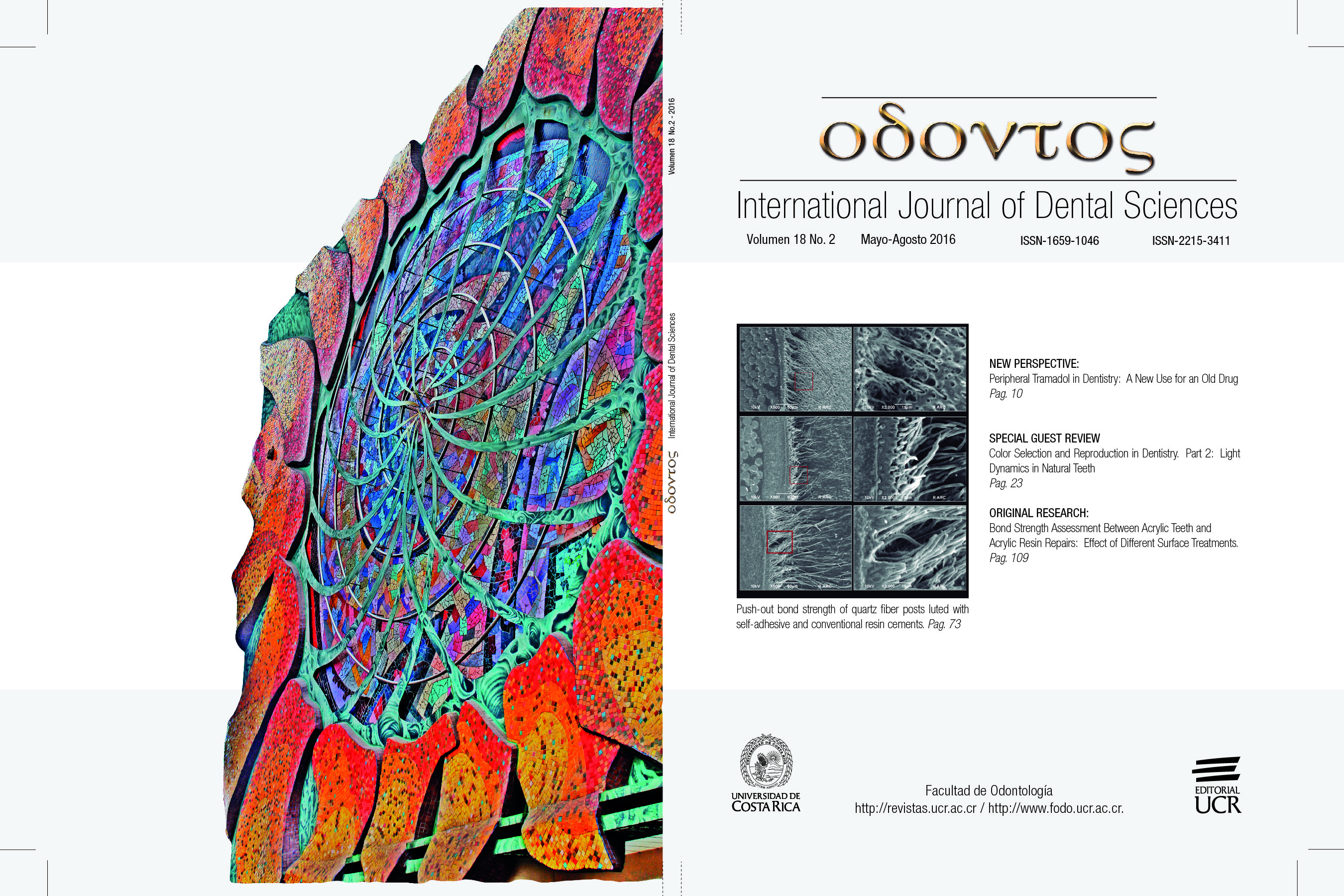Abstract
The aim of this study was to characterize the influence of the sintering type in the flexural strength and hardness of ceramic blocks for CAD-CAM. Four type of ceramic blocks were selected and distributed according to the type of sintering to be performed: Group G1 - In-Ceram® Alumina / liquid state; Group G2 - In-Ceram® AL / solid state; Group G3 - In-Ceram® Zircon / liquid state; Group G4 - In-Ceram® YZ / solid state. All blocks were cut in bar shape with dimensions of 25 x 5 x 2 mm. and submitted to the three-point bending test and to the Vickers hardness test method. The results, after statistical analysis, showed that the average flexural strength of group G1 (351.7 MPa) and group G3 (356.3 MPa) were significantly lower than those of group G2 (421.9 MPa) and group G4 (758.4 MPa); as well as all hardness averages were significantly different, being higher for group G2 (1.936,6 HV) and group G4 (1.321,4 HV), when compared to group G1 (1.173,3 HV) and group G3 (1.094,6 HV). It was concluded that the solid state sintering proved to be more efficient to obtain maximum densification of the ceramics blocks, resulting in high values of flexural strength and hardness.
References
Denry I. L. Recent advances in ceramics for dentistry. Crit Rev Oral Biol Med. 1996;7(2):134-143.
Rosenblum M. A., Schulman A. A Review of All-Ceramic Restorations. J Am Dent Assoc. 1997; 128 (3): 297-307.
Scherrer S. S., De Rijk W. G., Belser U. C. Fracture resistance of human enamel and three all-ceramic crown systems on extracted teeth. Int J Prosthodont. 1996; 9 (6): 580-585.
Brito FIG, Medeiros K. F., Lourenço J. M. Um estudo teórico sobre a sinterização na metalurgia do pó. Holos. 2007; 23 (3): 204-211.
Silva A., Alves Junior C. A. sinterização rápida: sua aplicação, análises e relação com as técnicas inovadoras de sinterização. Ceramica. 1998; 44 (290): 225-232.
Silva A., Alves Junior C. Teoria de sinterização por fase sólida; uma análise crítica de sua aplicação. Ceramica. 1998; 44 (289): 171-176.
Vita All-Ceramics, Vita In-Ceram® for inLab®, Spinell for inLab®, Alumina for inLab®, Zirconia for inLab®, porously sintered oxide ceramics blocks for glass infiltration. Directions for use, Fabrication of de substructures. Bad Säckingen: VITA Zahnfabrik; 2006. p. 52.
Vita All-Ceramics, Vita In-Ceram® 2000 AL cubes for inLab®, Aluminium oxide blocks for high-temperature sintering. Working Instructions fabrication of crown / bridge frameworks. Bad Säckin: VITA Zahnfabrik; 2005. p. 18.
Vita Cerámicas sin metal, Vita In-Ceram® YZ cubes for CEREC®. Instrucciones de uso para la elaboración de estructuras de coronas y puentes. Bad Säckingen: VITA Zahnfabrik; 2004. p. 19.
Schalch MV. Resistência à flexão, resistência à tração diametral e dureza de sistemas cerâmicos para infra-estruturas [Mestrado]. Araraquara: Faculdade de Odontologia de Araraquara; 2003.
Weibull W. A statistical distribution function of wide application. J Appl Mech. 1951; 9: 293-297.
Oliva E. A. Influência do método de processamento, sinterização convencional ou injeção a vácuo, na resistência à flexão e dureza de porcelanas feldespáticas [Doutorado]. Araraquara: Faculdade de Odontologia da UNESP; 2006.
Seghi R. R., Denry I. L., Rosenstiel S. F. Relative fracture toughness and hardness of new dental ceramics. J Prosthet Dent. 1995; 74 (2): 145-150.
Wagner W. C., Chu T. M. Biaxial flexural strength and indentation fracture toughness of three new dental core ceramics. J. Prosthet Dent. 1996; 76 (2): 140-144.
Beck H. Estudo de cerâmicas de CeO2-ZrO2-Al2O3 consolidadas por infiltração e sinterização na presença de vidro visando aplicações estruturais [dissertação de mestrado]. São José dos Campos: Instituto Nacional de Pesquisas Espaciais; 2006.
Nono M. Cerâmicas de zircônia tetragonal policristalina no sistema CeO2-ZrO2 (Ce-TZP) [tese de doutorado]. São José dos Campos: Instituto Tecnológico de Aeronáutica; 1990.
Tinschert J., Zwez D., Marx R., Anusavice K. J. Structural reliability of alumina-, feldspar-, leucite-, mica- and zirconia-based ceramics. J Dent. 2000; 28 (7): 529-535.
Hwang J. W., Yang J. H. Fracture strength of copy-milled and conventional In-Ceram crowns. J Oral Rehabil. 2001; 28 (7): 678-683.
Apholt W., Bindl A., Lüthy H., Mörmann WH. Flexural strength of Cerec 2 machined and jointed InCeram-Alumina and InCeram-Zirconia bars. Dent Mater. 2001; 17 (3): 260-267.
Seghi R. R., Sorensen J. A. Relative flexural strength of six new ceramic materials. Int J Prosthodont. 1995; 8 (3): 239-246.
Bindl A., Mörmann W. H. An up to 5-year clinical evaluation of posterior In-Ceram CAD/CAM core crowns. Int J Prosthodont. 2002; 15: 451-456.
Snyder M. D., Hogg K. D. Load-to-fracture value of different all-ceramic crown systems. J Contemp Dent Pract. 2005; 6 (4): 54-63.
Chong K. H., Chai J., Takahashi Y., Wozniak W. Flexural Strength of In-Ceram Alumina and In-Ceram Zirconia Core Materials. Int J Prosthodont. 2002; 15 (2): 183-188.
Evans D. B., O'Brien W. J. Fracture Strength of Glass Infiltrated-Magnesia Core Porcelain. Int J Prosthodont. 1999; 12 (1): 38-44.
Esquivel-Upshaw J. F., Chai J., Sansano S., Shonberg D. Resistance to Staining, Flexural Strength, and Chemical Solubility of Core Porcelains for All-Ceramic Crowns. Int J Prosthodont. 2001; 14 (3): 284-288.
Fischer H., Weisβ R., Telle R.. Crack healing in alumina bioceramics. Dent Mater. 2008; 24: 328-332.
Giordano 2nd R. A., Pelletier L., Campbell S., Pober R. Flexural strength of an infused ceramic, glass ceramic, and feldspathic porcelain. J. Prosthet Dent. 1995; 73 (5): 411-418.

